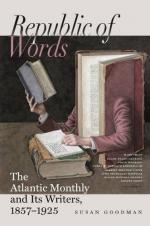The interest inspired by these simple narratives suggests the reflection, that literature, which has thus far portrayed so few aspects of external Nature, has described almost nothing of winter beauty. In English books, especially, this season is simply forlorn and disagreeable, dark and dismal.
“And foul
and fierce
All winter drives along the darkened air.”
“When dark December shrouds the
transient
day,
And stormy winds are howling in
their
ire,
Why com’st not thou?. ... Oh,
haste to pay
The cordial visit sullen hours require!”
“Winter will oft at eve resume the
breeze,
Chill the pale morn, and bid his
driving
blasts
Deform the day delightless.”
“Now that the fields are dank and
ways are
mire,
With whom you might converse, and
by the
fire
Help waste the sullen day.”
But our prevalent association with winter, in the Northern United States, is with something white and dazzling and brilliant; and it is time to paint our own pictures, and cease to borrow these gloomy alien tints. One must turn eagerly every season to the few glimpses of American winter aspects: to Emerson’s “Snow-Storm,” every word a sculpture,—to the admirable storm in “Margaret,”—to Thoreau’s “Winter Walk,” in the “Dial,”—and to Lowell’s “First Snow-Flake.” These are fresh and real pictures, which carry us back to the Greek Anthology, where the herds come wandering down from the wooded mountains, covered with snow, and to Homer’s aged Ulysses, his wise words falling like the snows of winter.
Let me add to this scanty gallery of snow-pictures the quaint lore contained in one of the multitudinous sermons of Increase Mather, printed in 1704, entitled “A Brief Discourse concerning the Prayse due to God for His Mercy in giving Snow like Wool.” One can fancy the delight of the oppressed Puritan boys, in the days of the nineteenthlies, driven to the place of worship by the tithing-men, and cooped up on the pulpit-and gallery-stairs under charge of the constables, at hearing for once a discourse which they could understand,—snow-balling spiritualized. This was not one of Emerson’s terrible examples,—“the storm real, and the preacher only phenomenal”; but this setting of snow-drifts, which in our winters lends such grace to every stern rock and rugged tree, throws a charm even around the grim theology of the Mathers. Three main propositions, seven subdivisions, four applications, and four uses, but the wreaths and the gracefulness are cast about them all,—while the wonderful commonplace-books of those days, which held everything, had accumulated scraps of winter learning which cannot be spared from these less abstruse pages.




